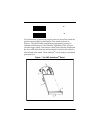
06656 1
Introduction
Keyboard Wedge Mode
As a keyboard wedge interface, the PSC scanner can be used with ter-
minals provided by most of the major terminal manufacturers. In
most cases, the PSC scanner is easily connected between the key-
board and display of the terminal. The use of Preamble/Postamble,
embedded keyboard function codes or keyboard function records
allow operation of the terminal without manual entry from the key-
board. In this mode of operations, the PSC scanner draws power from
the terminal.
Serial Communications Mode
The PSC scanner can be configured by the user for a serial communi-
cation output. In this mode, the scanner can be connected to any
device that accepts serial ASCII data at TTL voltage levels. RS232
voltage levels can be achieved by the use of an optional RS232 con-
version pod.
AutoSense
®
Mode
The PSC scanner may be configured at the factory with PSC’s
AutoSense
®
feature. AutoSense
®
operates with a passive stand for
hands-free operation. When the scanner is placed in the stand, it
becomes immediately active for reading any bar code label presented
to it. The user can remove the scanner from the AutoSense
®
Stand
and use it as a conventional hand-held scanner. When replaced in the
stand, the scanner reverts automatically to AutoSense
®
.
Wand Emulation Mode
The PSC scanner can be configured by the user for Wand Emulation.
In this mode, the PSC scanner can be connected to any device that
accepts a wand signal input. Wand Emulation communication pre-
sents bar code data to a host device exactly as a wand does. This pre-
cludes the use of any option which adds information to the bar code
symbol data (preamble, for example). A typical example of this
would be to interface the scanner to a portable data terminal for
remote data collection.
Magnetic Stripe Reader
Magnetic stripe reading capabilities are available with appropriate
cabling.


















